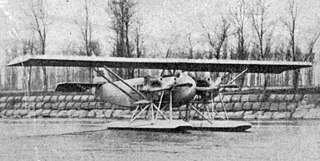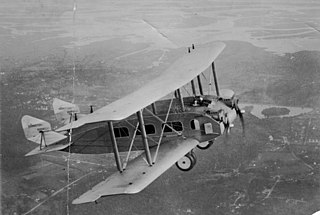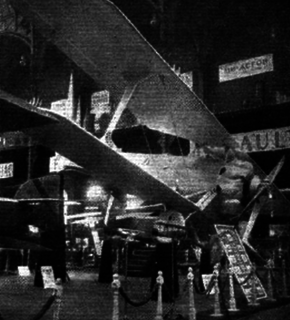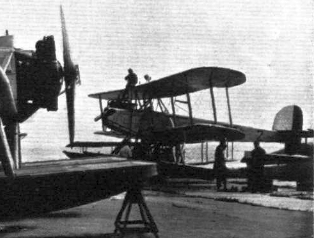| DAR 4 | |
|---|---|
 | |
| Role | Airliner |
| Manufacturer | DAR |
| First flight | 1930 |
| Number built | 1 |
The DAR 4 was a prototype airliner built in Bulgaria in 1930.
| DAR 4 | |
|---|---|
 | |
| Role | Airliner |
| Manufacturer | DAR |
| First flight | 1930 |
| Number built | 1 |
The DAR 4 was a prototype airliner built in Bulgaria in 1930.
The DAR 4 was a conventional biplane design, with unstaggered wings of unequal span braced with Warren trusses. The fuselage offered fully enclosed accommodation for the two pilots and four passengers. A curious feature of the design was that the top wing was not attached directly to the top of the fuselage as is common in cabin biplanes, but was mounted above it with cabane struts. Power was provided by three radial engines; one in the nose, and one mounted on each lower wing where the struts met. Performance was disappointing, and in particular, the narrow track of the undercarriage created difficulties. After the single prototype, no further examples were built.
General characteristics
Performance

The DAR 10 was a Bulgarian light bomber and reconnaissance aircraft. DAR-10 was designed for horizontal and dive bombing, reconnaissance, and ground attack.

The Avia BH-6 was a prototype fighter aircraft built in Czechoslovakia in 1923. It was a single-bay biplane of unusual configuration, developed in tandem with the BH-7, which shared its fuselage and tail design.

The Avro Type E, Type 500, and Type 502 made up a family of early British military aircraft, regarded by Alliott Verdon Roe as his firm's first truly successful design. It was a forerunner of the Avro 504, one of the outstanding aircraft of the First World War.

The Friedrichshafen G.I was a prototype heavy bomber aircraft that was built in Germany by Flugzeugbau Friedrichshafen in 1915. It was Karl Gehlen's first design for the company, and although it was not produced in quantity, it provided the foundation for the later, highly successful bombers culminating in the G.III.

The Latécoère 15 was a French airliner built in 1925 for use on Latécoère's own airline on routes between France and Morocco. It was a parasol-wing monoplane of conventional design, with twin engines mounted among the wing bracing struts, and small stub wings fitted to the lower fuselage as a mounting point for these struts and for the main undercarriage units. Six passengers could be carried in an enclosed cabin, and the pilot sat in an open cockpit in the nose.

The de Havilland DH.27 Derby was a large single-engined biplane designed to a heavy day bomber Air Ministry specification. It did not reach production.
The Junkers J 15 was an all-metal monoplane built in Germany in 1920 to explore the design parameters of small single-engined passenger transports. In particular, it could fly in either high or low wing configurations. It led to the Junkers J 16 light airliner.
The Junkers T 23 was a two-seat, single-engined experimental training aircraft, built in Germany in the early 1920s. It could be configured either as a parasol winged monoplane or as a biplane to compare handling characteristics. 4 were constructed.

The Burnelli RB-1 was a US twin engine biplane airliner prototype from 1920, incorporating a lifting body fuselage.

The Wibault 2, Wib 2 or Wib 2 BN.2 was a single engine biplane aircraft designed and built in France in the early 1920s. It was intended as a heavy night bomber, though a thirteen-seat passenger version was proposed. Only one was built.

The Letov Š-3 was a single-seat, single-engine parasol wing fighter aircraft designed and built in Czechoslovakia in the early 1920s. Only one was completed and flown, its makers preferring to develop a biplane fighter.

The Hanriot H.31 was a single engine, single seat French biplane fighter aircraft built in 1925 to compete in a government programme. It was not successful and only one prototype was completed.

The LFG V 60 was a small, single engine, tandem seat floatplane training aircraft, designed and built in Germany in the mid-1920s. About five were constructed.
The Schütte-Lanz D.VII was a single engine, biplane fighter aircraft designed and built in Germany towards the end of World War I.
The Williams-Cangie WC-1 Sundancer is an American homebuilt biplane racing aircraft that was designed by Art Williams and Carl Cangie and built by Ralph Thenhaus in 1974. Plans were at one time available from Williams' company, the Williams Aircraft Design Co of Northridge, California. Only one was built.

The Caudron C.74 was a ten-seat, four engine passenger biplane built in France in 1922. It showed promise but the sole prototype crashed fatally in a competition and no more were completed.

The Caudron C.67 was a simple single seat biplane with a low powered engine. It was built and flown in France in 1922.
The Caudron C.37 was a French three-engined biplane passenger transport, built in 1920. It could carry six passengers.

The Caudron C.25 was a large, three-engined, biplane airliner, designed and built in France soon after the end of World War I. Its enclosed cabin could accommodate up to eighteen passengers.

The Zeppelin-Lindau Gs.I, often known post-WWI as the Dornier Gs.I after its designer Claude Dornier, was a civil flying boat developed immediate post-war from a military prototype. Its passenger cabin seated six. Only one was completed, and that was eventually scuttled to keep it out of Allied hands. Another of the military prototypes was intended to have a bigger, nine seat cabin and other refinements but the Gs.II was incomplete when discovered by Allied inspectors.
| Wikimedia Commons has media related to DAR 4 . |